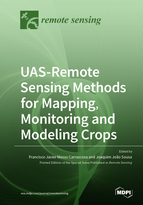UAS-Remote Sensing Methods for Mapping, Monitoring and Modeling Crops
A special issue of Remote Sensing (ISSN 2072-4292). This special issue belongs to the section "Environmental Remote Sensing".
Deadline for manuscript submissions: closed (15 September 2020) | Viewed by 30652
Special Issue Editors
Interests: UAV; remote sensing
Special Issues, Collections and Topics in MDPI journals
Interests: UAV; image processing algorithms (RGB, NIR, multi- and hyperspectral, thermal and LiDAR sensors); InSAR; precision agriculture; precision forestry
Special Issues, Collections and Topics in MDPI journals
Special Issue Information
Dear Colleagues,
Advances in UASs have aroused the interest of the agricultural community. The near-continuous observation using RGB, multispectral, hyperspectral, thermal, and/or LiDAR sensors, registering data with an ultrahigh spatial resolution, allows not only the mapping, but also monitoring and modeling characteristics of crops, which thus improves decision-making processes by farmers. It is clear then that the developing methods have improved the processing and analysis of UAS data in agricultural scenarios and will continue to help to advance the important work in the agricultural community.
This Special Issue includes original and innovative manuscripts demonstrating the use of UASs for remote sensing in agricultural areas. The selection of papers for publication will depend on the quality and rigor of the research and paper. Specific topics include but are not limited to:
- UAS-based RGB imaging in agriculture;
- UAS-based multispectral imaging in agriculture;
- UAS-based hyperspectral imaging in agriculture;
- UAS-based thermal imaging in agriculture;
- UAS-based laser scanning in agriculture;
- Multitemporal analysis;
- Artificial intelligence in remote sensing;
- Accuracy and precision evaluations of UAS-based techniques;
- Integration of UAS data with ground-based data or other measurements;
- Precision agriculture applications.
Prof. Dr. Francisco Javier Mesas Carrascosa
Prof. Dr. Joaquim João Moreira de Sousa
Guest Editors
Manuscript Submission Information
Manuscripts should be submitted online at www.mdpi.com by registering and logging in to this website. Once you are registered, click here to go to the submission form. Manuscripts can be submitted until the deadline. All submissions that pass pre-check are peer-reviewed. Accepted papers will be published continuously in the journal (as soon as accepted) and will be listed together on the special issue website. Research articles, review articles as well as short communications are invited. For planned papers, a title and short abstract (about 100 words) can be sent to the Editorial Office for announcement on this website.
Submitted manuscripts should not have been published previously, nor be under consideration for publication elsewhere (except conference proceedings papers). All manuscripts are thoroughly refereed through a single-blind peer-review process. A guide for authors and other relevant information for submission of manuscripts is available on the Instructions for Authors page. Remote Sensing is an international peer-reviewed open access semimonthly journal published by MDPI.
Please visit the Instructions for Authors page before submitting a manuscript. The Article Processing Charge (APC) for publication in this open access journal is 2700 CHF (Swiss Francs). Submitted papers should be well formatted and use good English. Authors may use MDPI's English editing service prior to publication or during author revisions.
Keywords
- Accuracy and precision
- Agriculture
- Ecosystem
- Hyperspectral
- Laser scanning
- Multispectral
- Phenology
- Object extraction
- Plant physiology
- Plant structure
- RGB
- Spatiotemporal patterns
- Thermal
- UAV
- UAS
- Vegetation
- Vegetation indices
- Vitality






